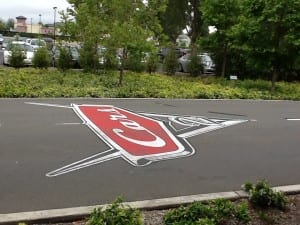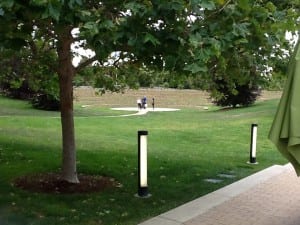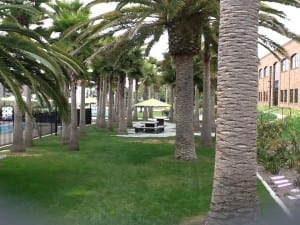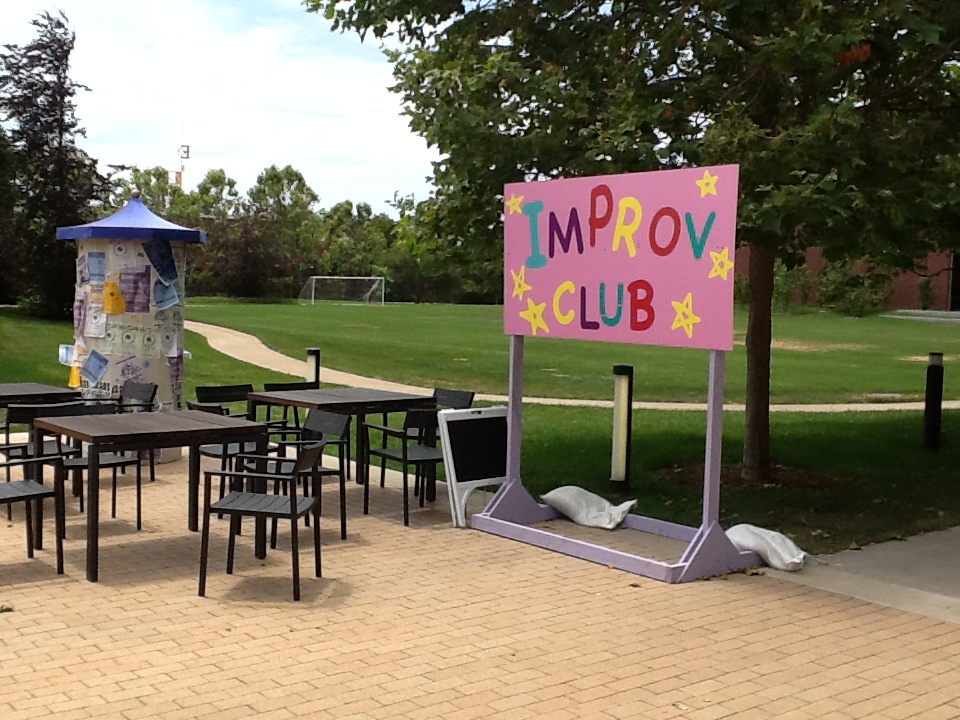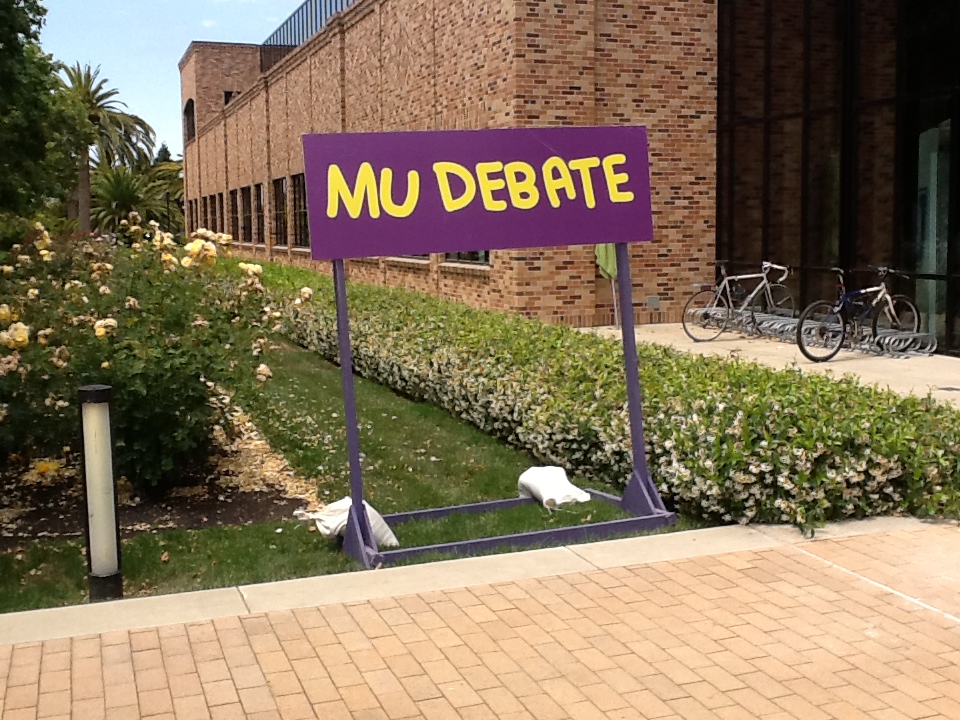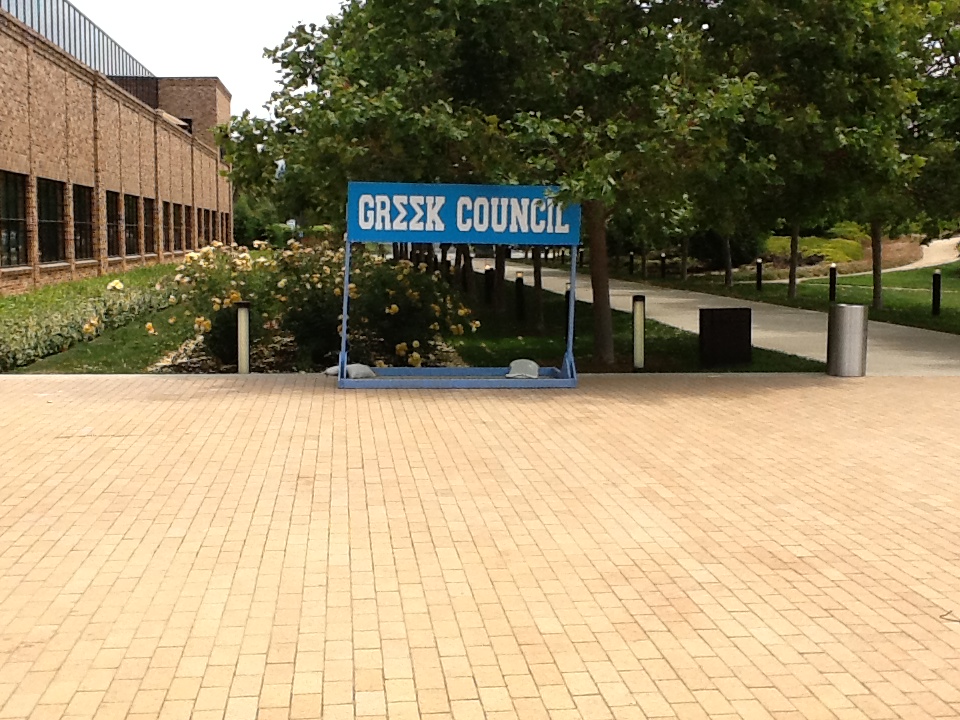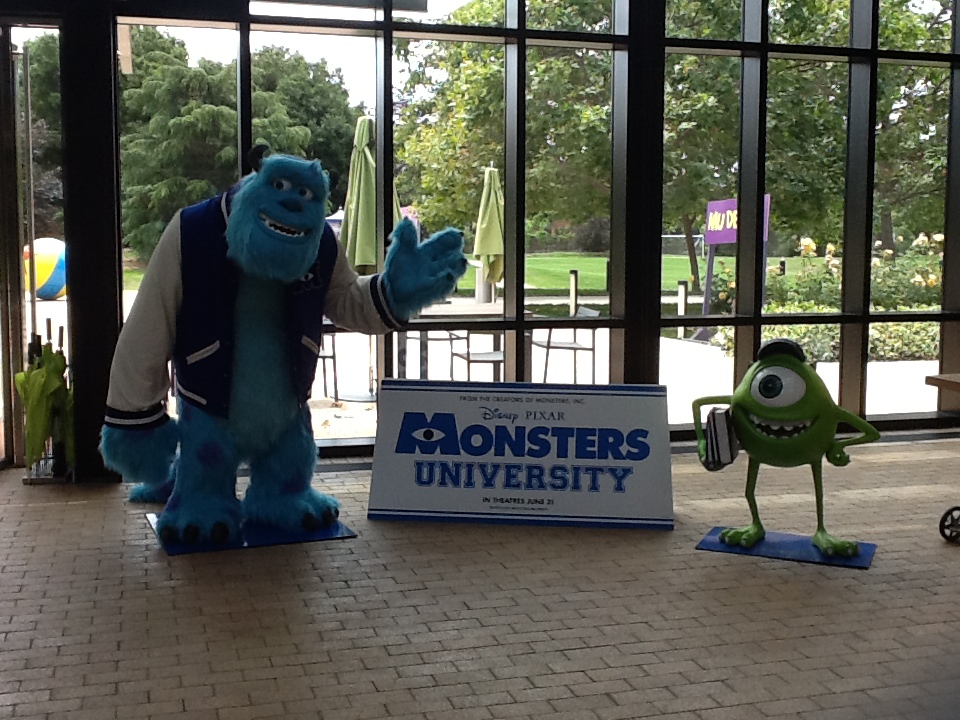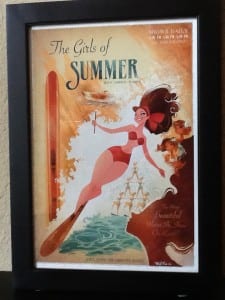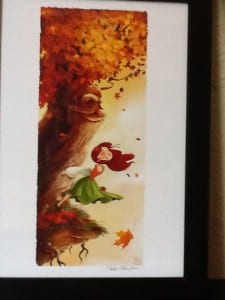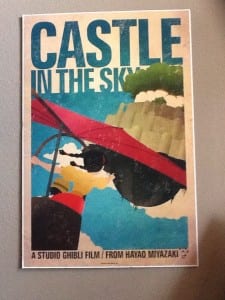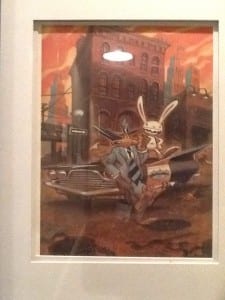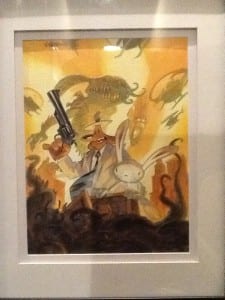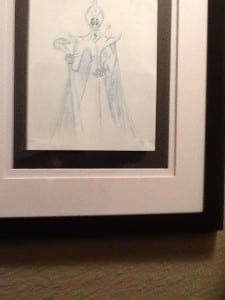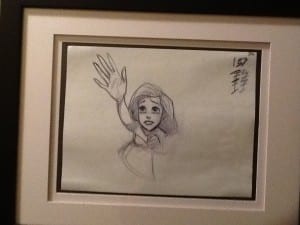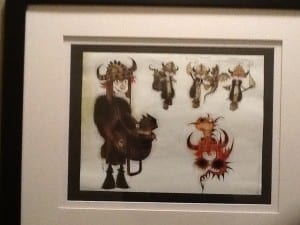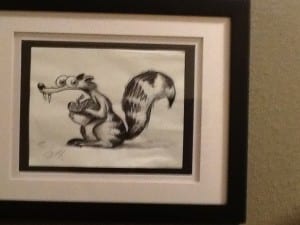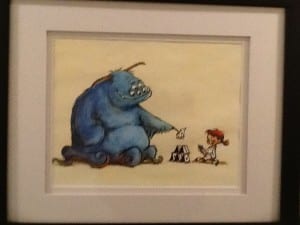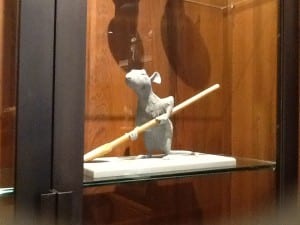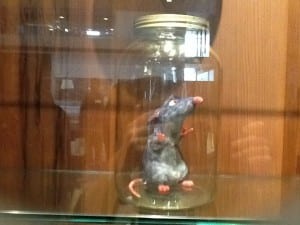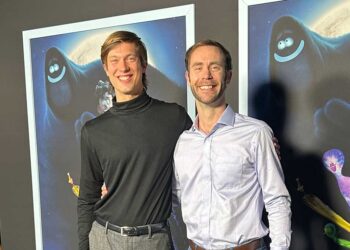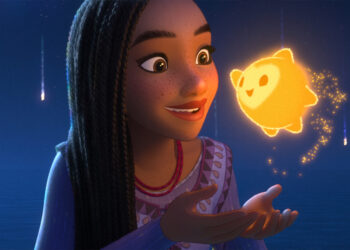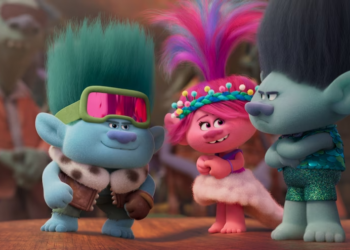Pixar is a locked down studio. There are only three ways to officially get in: be an employee, know someone who works at the magical wonderland, or be invited to a press event. There is, however, a fourth way into Pixar that is only whispered about behind the black gate covered in twining roses and plastic mesh screens to block out prying eyes or the odd fanatic who would try to scale the fence. It involves passing a little green cash under the table, better described as bribery, and that is how I got in. 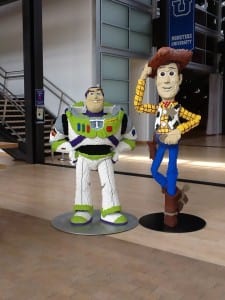
Before I get my contact in trouble, because the Disney-Pixar higher-ups would frown on someone taking advantage of their position (though I assume some might find it humorous), I did not really “bribe” my way into Pixar. I did pay for the privilege via an eBay auction, but my hard earned cabbage was actually a tax-deductible donation to the Montclair School System. School children will have new supplies and in exchange I got Pixar and a personal tour guide named Victor Navone for a day.
It Starts With A News Link
How did my adventure begin? After I discovered a news link for a live eBay auction for the tour, I won a spot on a Pixar tour with a special viewing of The Blue Umbrella, which the film’s director had donated to the local school district. It was March when I won the auction, so for three months I bided my time by arguing with customer support people in India about rerouting my vacation to San Francisco. They lost, I triumphed, but I am sure we shall meet in battle again. Time ticked by, until summer premiered on the horizon with rain, humidity, and advertisements for Monsters University. My tour was scheduled days before the summer blockbuster’s opening, making it even cooler to kindly brag to friends about where I was going.
The day finally arrived, so I boarded a couple planes and time travelled across the country to Emeryville, CA. It was late afternoon by the time I checked into my hotel and decided to scout out the Pixar campus to prevent myself from getting lost on the morrow. I walked for fifteen minutes following smartphone directions, wondering where the studio was among the quaint brick buildings and purple floral landscaping, when I noticed a giant seagull from Finding Nemo on top of a roof behind a black fence. Copyright laws and Hollywood’s mad need to keep projects secret led me to deduce this was the fabled studio that danced around in my imagination for years.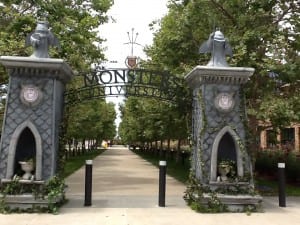
With my heart pounding and a smile on my face, I did the one thing any Pixar fan would do: I went in search of the studio dumpster. Actually, I had come up behind the campus into the loading area with the dumpster. My actual plan was to walk around the entire campus and perhaps catch a glimpse of someone I recognized from a DVD special features or TV interview.
I began to walk around, peeking between the metal bars to gaze at the beautiful campus behind the mesh screens. There were many employee entrances cut into the fence and they gain entry using a key card that makes the requisite “ERR” and “click” security sound. These entrances were also the best way to see behind the fence and I took the liberty to look in. From my perspective, I was not doing any harm, simply an innocent fan looking into the studio where some of the best animated movies in the world are made. A few employees came out of these gates and we traded glances and I nodded hello. I guess my perceived innocence was not projected onto my outward appearance. Having been travelling all day, I was wearing dark jean capris, navy blue sneakers, a dark blue windbreaker, plus a black bandana to keep my hair back. I also wore my backpack with my iPad, water, and purse. Coupled with my tendency to pass as a high-schooler, in retrospect I realize I probably looked like a teenage hoodlum.
Do the math: wearing dark clothing, a backpack, and walking around a large entertainment icon’s back alley taking pictures. What does that add up to? It equals me peeking into an employee entrance with an Asian woman coming out dressed in professional attire. I smiled and moved out of the way, assuming as a Pixarian she would respond likewise. She paused and looked at me. Not thinking much of it, I continued to walk on when I felt her eyes boring into my back. I stopped, turned around, and caught her giving me the suspicious once over. Realization then dawned on me.
Oops! What did I do? I was not doing anything wrong and knew it, so I stopped and stared at her. Fan vs. Pixar employee, cue The Good, The Bad, and The Ugly music. After five minutes, she turned away with the occasion glance over her shoulder and I returned to my exploration, hoping not to see her the next day and wondering what she did at Pixar.
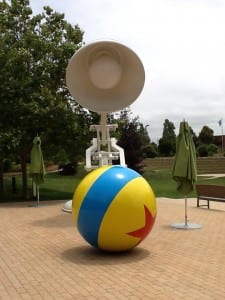 Moving forward, I finally found myself at the main gate. Imagine the opening title sequence of any Pixar film before Luxo the hopping lamp comes out and kills the letter “i.” Now bring the letters into real life with a setting sun behind them casting long shadows on the ground and burning the letters into the sky. I am exaggerating a little, but seeing the studio’s front entrance with the logo was a little surreal. I understand that individual humans spend long hours working on everything from storyboards to the texture of clothing, but I amalgamate them into one giant being in my head that goes by the name Pixar, wears a Hawaiian shirt, and pops its dreams out of its head once a year to share with humanity. It was a small shock to realize that this place was not the creature of my imagination, but instead a company with the shop closing up for the weekend.
Moving forward, I finally found myself at the main gate. Imagine the opening title sequence of any Pixar film before Luxo the hopping lamp comes out and kills the letter “i.” Now bring the letters into real life with a setting sun behind them casting long shadows on the ground and burning the letters into the sky. I am exaggerating a little, but seeing the studio’s front entrance with the logo was a little surreal. I understand that individual humans spend long hours working on everything from storyboards to the texture of clothing, but I amalgamate them into one giant being in my head that goes by the name Pixar, wears a Hawaiian shirt, and pops its dreams out of its head once a year to share with humanity. It was a small shock to realize that this place was not the creature of my imagination, but instead a company with the shop closing up for the weekend.
The sense of awe remained, however, as would anything behind a black fence with security guards. I would not compare the fence to the one that surrounded Sleeping Beauty’s castle, even if it did have roses, because Pixar does not have a fairy tale track record (aside from Brave). It was more like getting a chance to look behind the curtain where the Wizard of Oz hid himself, except in this case the Wizard would indeed prove to be real and made up of hundreds of people.
And I would have my chance the next day.
Enter a Cold and a Cool Dude
I popped out of bed the next morning with a sore throat, headache, and a runny nose. Groans of self-pity laced with nose blows were the only sounds I made as I inwardly cursed the germs. Thirty dollars worth of medicine and caffeine later, I was pumped to head to Pixar…after a short late morning nap that shifted into an early afternoon nap, which I broke myself out of when the alarm went off. Pulling myself out of the oddly comfortable hotel bed and fighting a dizzy spell, I downed more caffeine and sauntered over to Pixar. My excitement bubbled as I approached the gate, though it could have been the bubbles from the soda I drank. Unlike last night, when I was mistaken for a hoodlum, I approached the security booth, showed my ID, and was issued a visitor’s pass. I asked the security guard if a lot of people came up to the studio wanting to go in and he said all the time. My pity would usually be siding with those poor, unfortunate souls who are stuck on the other side of gate, because most of the time that is where I am. Not today, however, as the gate buzzed and I walked to the main campus with the giant Luxo lamp and star ball.
In the center of Pixar’s campus, I only lasted a total of 7.33 minutes before I geeked out. Yes, I did time it. Unlike my younger days, though, instead of jumping up and down or running around in circles and sputtering off facts with my speed talking skills, I silently walked around in a circle and took photos of everything. My thoughts were as follows: “Oh look! A Pixar tree! Now it’s a Pixar rock! Even better a Pixar ant, he must have been in A Bug’s Life!” And that continued on for the next four hours.
Beyond the fangirl thoughts drumming through my mind, my professional writer’s mentality kicked in and absorbed the other details. The week prior to my arrival, Pixar had hosted a large PR event for Monsters University. They had decked out the studio and campus as if it were a real college orientation day for the pretend scare school. There had been information booths, scare-leaders, and other activities. The remains still littered the area beneath Luxo’s unblinking gaze. Two things that I enjoyed the most were a replica of MU’s gate and a circular kiosk with fliers for campus happenings. I almost took a flier as a souvenir, but my morals got the better of me.
Other people who had won the sister auctions began to show up, many of them I would come to learn were animations students. We gathered around the center and made small talk, until a guy approached us. He introduced himself as Victor Navone in the most casual of manners that was a sharp contrast to my excitement. I studied Victor as he talked with late arrivals, noting his demeanor, choice of clothing, and laid back attitude coupled with humor. After a close observation, I made the conclusion that, indeed, he was a cool dude.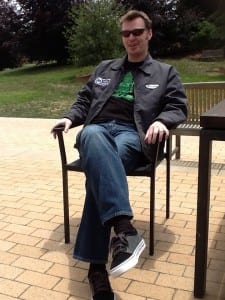
When the head count was complete, Victor led us off campus through one of the many key card entrances I had discovered the day before and across the street to the Animation Collaborative. The Animation Collaborative is a school that teaches animators how to improve the professional quality of their work. They offer a range of workshops and the faculty consists of notable animators, including many Pixarians. Victor was a teacher at the Collaborative at the time and he allowed us to explore the lobby. Cue big geeking out moment number two as I examined the walls. There was original concept art for many Disney movies, an art deco poster for Miyazaki’s Castle in the Sky, original art done by the students, and production statues from non-Disney parties. It was a miniature museum for the animation buff and I knew the day would only get better from here.
Visiting the Collaborative
We gathered in one of the classrooms, where Victor talked about his background. Like most animators, Victor loved drawing while he was growing up–mainly a lot of stuff labelled as geek fandoms. He wanted to be an illustrator and did the usual art track at the University of Irvine, when he got an internship at a videogame company. After his internship was complete, Victor was hired on as a concept designer for Myst-style adventure games. Things were going well for a while as he designed scenery and did a tiny bit of voice acting.
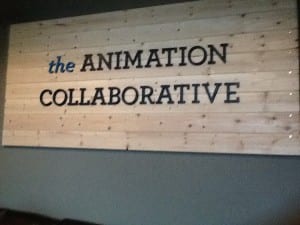 Life teaches us never to be complacent and Victor kept pushing himself to gain bigger and more high-tech skills. These were the early days of computer animation and the advent of CD-Roms, so he was able to acquire animation software rather cheaply. The fruit of his labors produced one of the first Internet memes: the alien singing “I Will Survive.” He was responsible for slowing down the Internet in the golden age of AOL and dial-up with this short video.
Life teaches us never to be complacent and Victor kept pushing himself to gain bigger and more high-tech skills. These were the early days of computer animation and the advent of CD-Roms, so he was able to acquire animation software rather cheaply. The fruit of his labors produced one of the first Internet memes: the alien singing “I Will Survive.” He was responsible for slowing down the Internet in the golden age of AOL and dial-up with this short video.
I remember when this video was first making the Internet rounds and I viewed it at my school’s computer lab, subsequently in all my classes where a teacher had a computer. The video was played so much at my school that it drove a few teachers nuts and an eventual ban on the video ensued. I was once more amazed and awed that the guy in the bomber jacket was responsible for making one of the first Internet memes. Victor later got an email from Pixar asking him if he wanted to come to a job interview. Thirteen years later, he has not left his little shed (more on that later).
When Victor received the email from Pixar, the company was still in its infantile stages. They were actively scouting talent, instead of the talent coming to them. He became an animator and has worked on all of the studio’s films since Monsters Inc. He has gone from creating Gloria Gaynor aliens to being the supervising animator on Inside Out. What did he do in-between Monsters Inc. and the yet to be released movie that takes place inside a human head?
Let’s form a list not copied from IMDB:
- Turned Frank Oz into Randall’s passive lackey, Fungus.
- He annoyed parents (and teachers) once more with the seagull “Mine, mine”
scene in Finding Nemo. - He demonstrated Dash’s super powers in the famous chase scene in The
Incredibles. - He was also one of the first to animate the villain Syndrome.
- He set the gas station stage in Mater and the Ghostlight for the tow truck to be
scared out of his oil can. - He made Linguini and Collette roller skate in Ratatouille.
- And he also helped Wall-E experience love in the comically sweet bench
scene. - He introduced Bonnie from Toy Story 3 to the greater world.
- He helped Finn McMissle and Mater meet in Cars 2.
- In Brave, he was responsible for making the mother eat the cursed cake.
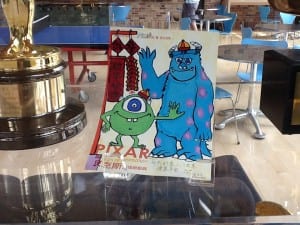 These are all pivotal and funny moments in Pixar’s films, but beyond meeting the person who conveyed the humor to the screen it was interesting to me how the animation process worked. At a movie studio like Pixar, they plot the entire story out similar to how an author creates a bone structure, then assign individual animators a segment–roughly a few minutes long–to work on and then they put them together. Victor told us that on average Pixar animates seventy-two frames a week, which equals a total of three seconds in a complete film! No wonder their production schedule used to be one movie every other year when they were still a “smallish” studio. Since they ramped up the release schedule, which did not seem to phase Victor, he stressed that all of Pixar’s animators are feature film editors because they have the ability to craft their work. The definition of an animator is loosely applied, because only ten percent of the people who work on the films are animators–the rest are responsible for sound, light, backgrounds, etc.
These are all pivotal and funny moments in Pixar’s films, but beyond meeting the person who conveyed the humor to the screen it was interesting to me how the animation process worked. At a movie studio like Pixar, they plot the entire story out similar to how an author creates a bone structure, then assign individual animators a segment–roughly a few minutes long–to work on and then they put them together. Victor told us that on average Pixar animates seventy-two frames a week, which equals a total of three seconds in a complete film! No wonder their production schedule used to be one movie every other year when they were still a “smallish” studio. Since they ramped up the release schedule, which did not seem to phase Victor, he stressed that all of Pixar’s animators are feature film editors because they have the ability to craft their work. The definition of an animator is loosely applied, because only ten percent of the people who work on the films are animators–the rest are responsible for sound, light, backgrounds, etc.
We were then treated to Victor’s “introduction to animation” class. He started with how an animator in the traditional sense draws a lot of pictures to give the illusion of movement, while a computer animator is more of a digital puppeteer that controls every little movement and does not have to be a good draftsman. Differences aside, both must act as technicians to understand the laws of physics, be storytellers, actors, and play well with others.
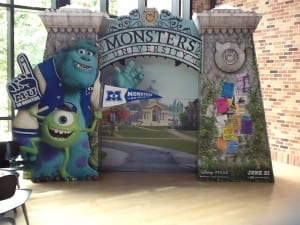 Computer animation crosses into territory that traditional animation never even touches. It allows for more detailed and geometric images with fine grain controls and subtlety of motion. The undo button is very important, especially when dealing with new techniques. The problems are that 3D animation is expensive and an extremely slow process, because everything has to be built from the ground up. Even though computers can do remarkable things, without a human hand to guide them the end results are ugly.
Computer animation crosses into territory that traditional animation never even touches. It allows for more detailed and geometric images with fine grain controls and subtlety of motion. The undo button is very important, especially when dealing with new techniques. The problems are that 3D animation is expensive and an extremely slow process, because everything has to be built from the ground up. Even though computers can do remarkable things, without a human hand to guide them the end results are ugly.
The human element is what makes animation an art form. Victor discussed Frank Thomas and Ollie Johnson’s, two of the Nine Old Men, twelve principles of animation. Frank and Ollie were best friends and collaborated on a book, The Illusion of Life, that is an animation staple to this day. He presented the material in an interesting manner that gave me a greater understanding about the animation process. While he only went over the basic principles, the most important function I learned was animators strive to mesh all of these concepts into a cohesive package. They must take into account each one, otherwise they are left with a gunky end product.
Timing is the principle that struck me as the most important, because, as they say, it is everything. When you deliver a joke’s punch line you wait for the opportune moment to receive the most laughs. If you give it too soon or too late then the joke dies away and no one will crack a grin. Timing gives items weight and carries an entire movie.
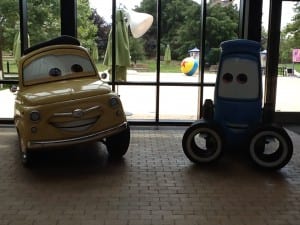 Exaggeration came off as Victor’s favorite principle. For him, exaggeration means a caricature of life and animation uses this principle to make it more engrossing and understandable. He gave us examples by two famous artists: Jessie Lipscomb and Camille Claudel. Each woman sculpted the same subject and gave their work the same name, Giganti, but their individual takes were quite different. Claudel’s was more handsome and pleasing to look at, while Jessie Lipscomb was grotesque. Claudel and Lipscomb sculpted the same subject, but their different takes make the viewer understand it from differing perspectives. Exaggeration can affect the way people think and view life.
Exaggeration came off as Victor’s favorite principle. For him, exaggeration means a caricature of life and animation uses this principle to make it more engrossing and understandable. He gave us examples by two famous artists: Jessie Lipscomb and Camille Claudel. Each woman sculpted the same subject and gave their work the same name, Giganti, but their individual takes were quite different. Claudel’s was more handsome and pleasing to look at, while Jessie Lipscomb was grotesque. Claudel and Lipscomb sculpted the same subject, but their different takes make the viewer understand it from differing perspectives. Exaggeration can affect the way people think and view life.
Victor next explained his approach to animation. Before he even sits down at his computer, Victor does a lot of thinking and plotting. Everything starts with a briefing about why a sequence is in a film and how it adds to the overall story. Research is an important aspect of the process, because animators cannot just sit down at their monitor and start working. They need to figure out what to use and what to ignore, as even the smallest iota can change the sequence’s meaning. Exploring a character via tests allows the animator to play around with different ideas and how certain personality traits will shape the character throughout the film.
After the initial research is done, the animator has to create the scene. This is when the animator goes on a quest for the elusive inspiration animal. They turn to any source that could yield inspiration’s hiding spot: other animated films, family, friends, YouTube, pets, books, etc. Victor uses thumbnail sketches to explore potential ideas and if inspiration hits like a bolt of lightening blocking techniques are then around the corner. Block techniques are a rough draft of a scene–similar to storyboards or a comic book. It is the best time to try different shots, poses, and gestures as well as planning complex actions. Timing, texture, and simple character shots are explored with the layered technique, which is less about action and more about the finer details.
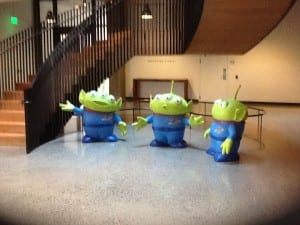 Once the initial planning process is finished, then Victor animates and works on several options for the same scene–sort of like having many product versions to see what a client likes best. He demonstrated by showing a scene from The Incredibles where a henchman is knocked unconscious. Victor had animated five or six ways the soldier was knocked out, one even had his head severed as a joke. Revisions constantly occur and the process is never complete until the director gives the final okay. Just to blow off steam, animators create scenes that would never even make it into the film, i.e. killing a character, inserting non-Pixar properties into the scene, or doing something off base.
Once the initial planning process is finished, then Victor animates and works on several options for the same scene–sort of like having many product versions to see what a client likes best. He demonstrated by showing a scene from The Incredibles where a henchman is knocked unconscious. Victor had animated five or six ways the soldier was knocked out, one even had his head severed as a joke. Revisions constantly occur and the process is never complete until the director gives the final okay. Just to blow off steam, animators create scenes that would never even make it into the film, i.e. killing a character, inserting non-Pixar properties into the scene, or doing something off base.
Ending with a reel of creative alternate scenes, we laughed about how Pixarians were never too prideful of their work to make fun of it. It is doubtful if these alternate scenes ever made it on a DVD as a bonus feature, especially when copyright law comes into play.
Victor then checked his watch and told us it was time to head back over to the Pixar campus. While the animation class was informative and gave insights about how Pixar produces strong stories, I was finally going to see the place where some of my best imaginary friends were born. My biggest aim was to see the speakeasy and the ventilator shaft they turned into a secret room dubbed the Love Lounge.
The Holy Second Floor
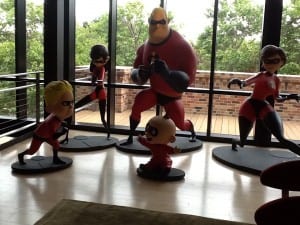 We passed a restaurant and a trophy case filled with Pixar’s awards, including Oscars, postcards created by children, and a much loved Woody doll to our first stop–the studio store that overflowed with Monsters University merchandise. I eyed a pennant and a couple T-shirts, but what really made me smile was an open-the-flap children’s book illustrated with ink and pen drawings. Most storybooks from Disney and Pixar usually repurpose art from the movies and very rarely is anything new made. Not only were these new drawings, but they were also an original artist’s interpretation of the movie. While studying the book, a mother and her daughter were looking at some items close to me. I glanced up as the child reached across the table in front of us and my eyes locked onto the mother. It was the same woman as the night before, who thought I was a teenage hoodlum. She did not notice me at first, but when she raised her head her eyes rounded in surprise and her mouth dropped open. Her daughter was pulling on her arm towards a stack of stuffed Sully’s and Mike’s, but she ignored it in favor of confused blinks. I waved my hand, smiled, and purchased the book. I wish I knew what thoughts buzzed through her head as she watched me leave the store.
We passed a restaurant and a trophy case filled with Pixar’s awards, including Oscars, postcards created by children, and a much loved Woody doll to our first stop–the studio store that overflowed with Monsters University merchandise. I eyed a pennant and a couple T-shirts, but what really made me smile was an open-the-flap children’s book illustrated with ink and pen drawings. Most storybooks from Disney and Pixar usually repurpose art from the movies and very rarely is anything new made. Not only were these new drawings, but they were also an original artist’s interpretation of the movie. While studying the book, a mother and her daughter were looking at some items close to me. I glanced up as the child reached across the table in front of us and my eyes locked onto the mother. It was the same woman as the night before, who thought I was a teenage hoodlum. She did not notice me at first, but when she raised her head her eyes rounded in surprise and her mouth dropped open. Her daughter was pulling on her arm towards a stack of stuffed Sully’s and Mike’s, but she ignored it in favor of confused blinks. I waved my hand, smiled, and purchased the book. I wish I knew what thoughts buzzed through her head as she watched me leave the store.
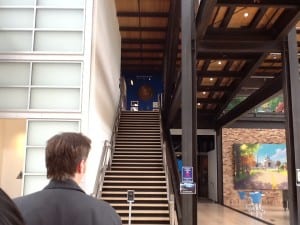 Victor was curious about what I purchased and enjoyed the book as much as I had (it was new to him as well). He was curious who had illustrated it and after looking at the title page said it was someone he knew from Pixar. My eyes popped out when I heard that, because I did not think Pixar took active participation in merchandising. Talk about in-house care. Victor politely told us not to take pictures of anything he was about to show us as most of what he was showing us was under strict copyright protection. Not wanting to offend Disney brass, so off went the iPad and cellphone as we trekked up the stairs to the second floor of the Steve Jobs Building.
Victor was curious about what I purchased and enjoyed the book as much as I had (it was new to him as well). He was curious who had illustrated it and after looking at the title page said it was someone he knew from Pixar. My eyes popped out when I heard that, because I did not think Pixar took active participation in merchandising. Talk about in-house care. Victor politely told us not to take pictures of anything he was about to show us as most of what he was showing us was under strict copyright protection. Not wanting to offend Disney brass, so off went the iPad and cellphone as we trekked up the stairs to the second floor of the Steve Jobs Building.
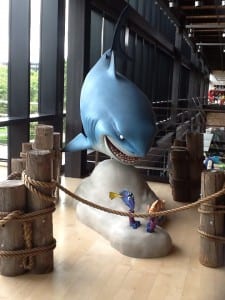 The entire floor was a museum to the Monsters University film. One can assume the idea behind this was to give the animators a place to sit down and be totally immersed in the movie world or it was set up after production for the press and other guests. The walls were covered with framed concept drawings and doodles of characters and places in the film, while model statues, used by animators to see how light and shadow play off the character’s angles and to see how they would actually look in a 3D world, were under glass cases. The model statues were surrounded by the concept art that led to their creation. It was amazing seeing how the artists conceptualized how a character should look and how the idea evolved into the final product. Different ideas were tested out as much as possible. Some of my personal favorites were the ouroboros librarian and the reference art for Dean Hardscrabble.
The entire floor was a museum to the Monsters University film. One can assume the idea behind this was to give the animators a place to sit down and be totally immersed in the movie world or it was set up after production for the press and other guests. The walls were covered with framed concept drawings and doodles of characters and places in the film, while model statues, used by animators to see how light and shadow play off the character’s angles and to see how they would actually look in a 3D world, were under glass cases. The model statues were surrounded by the concept art that led to their creation. It was amazing seeing how the artists conceptualized how a character should look and how the idea evolved into the final product. Different ideas were tested out as much as possible. Some of my personal favorites were the ouroboros librarian and the reference art for Dean Hardscrabble.
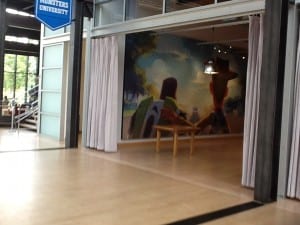 Another feature in the pseudo-museum was a tablet loaded with maps and information on locations in the Monsters University world. Victor mentioned in his class that computer animation requires animators to build worlds from scratch. Animators can then play around in these environments and I have always wanted to do to explore these places on my own. In Monsters Inc., I wanted to see what was around the corner of Mike and Sully’s apartment or what was in the alleyway behind Harryhausens and in Finding Nemo I want to know more about Marlin and Nemo’s neighborhood. DVD features can only take you so far and this tablet gave me the opportunity to visualize Monsters University in a life size landscape.
Another feature in the pseudo-museum was a tablet loaded with maps and information on locations in the Monsters University world. Victor mentioned in his class that computer animation requires animators to build worlds from scratch. Animators can then play around in these environments and I have always wanted to do to explore these places on my own. In Monsters Inc., I wanted to see what was around the corner of Mike and Sully’s apartment or what was in the alleyway behind Harryhausens and in Finding Nemo I want to know more about Marlin and Nemo’s neighborhood. DVD features can only take you so far and this tablet gave me the opportunity to visualize Monsters University in a life size landscape.
The only thing that was able to tear me away from the tablet (along with the Sesame Street rule of sharing) was Sherri Squibble’s living room from the movie. Sherri Squibble is Squishy’s supportive mother, who would make every sitcom mother proud as well as raise an eyebrow due to some of her odd habits. Everything was perfectly replicated down to the floral pattern on an armchair to the brick on the fireplace to the cross-stitched picture of a house. If I thought the tablet was great, the living room was fantastic. The tablet offered me the chance to get a scope of the monster world, but the living room had little details one cannot see on the screen even with an HD television and pause button. Pictures of Squishy as a child and other relatives paired with monster bric-a-brac gave the illusion that this living room did not belong to a human.
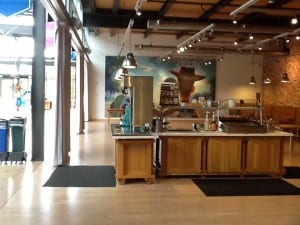 Also on the second floor was a gallery for animators to display their personal art. Pixar not only sports talented animators, but these folks are also skilled in other traditional mediums. I sadly do not remember the artist’s name, but his or her exhibit consisted of candy still lives. Still lives are never the most exciting exhibits. They require a patient eye to sweep out the details and how the colors play with light and shadow. Candy, because of its many colors and shapes, was the perfect way to make them more intriguing. The artist’s simple use of color immediately caught my eye and drew me closer to inspect each painting, but before I could spend the next hour to absorb all the sweetness we were pulled away to explore the inner sanctum also known as the office area.
Also on the second floor was a gallery for animators to display their personal art. Pixar not only sports talented animators, but these folks are also skilled in other traditional mediums. I sadly do not remember the artist’s name, but his or her exhibit consisted of candy still lives. Still lives are never the most exciting exhibits. They require a patient eye to sweep out the details and how the colors play with light and shadow. Candy, because of its many colors and shapes, was the perfect way to make them more intriguing. The artist’s simple use of color immediately caught my eye and drew me closer to inspect each painting, but before I could spend the next hour to absorb all the sweetness we were pulled away to explore the inner sanctum also known as the office area.
Pixar Does Not Believe in Cubicles
A Bug’s Life was a financial success and it gave Pixar the funds to build the Steve Jobs building (the building we were currently in). When they were crunching numbers to purchase office furniture, it was discovered that cubicle walls were expensive. As an alternative, some brilliant genius noted that garden sheds at a local hardware store were cheaper.
The sheds resembled a child’s playhouse more than a place to store tools. Each shed was roughly ten by fifteen feet with a window, a door, and roof. They fitted two people comfortably with room to stretch. Rather than have a bunch of dull, wood tool sheds in a large workspace, Pixar allows its employees to decorate their offices however they want. The studio unleashed a creative barrage as the animators attacked the sheds with fervor to transform the ordinary into the entertaining. One shed had been painted like a plastic dollhouse, another employee had transformed his shed into a medieval castle, and, my favorite was a jungle treehouse fort that someone had added a second floor to. Victor said the more elaborate an office was directly proportional to the amount of free time a person had–usually the workers who did not have families waiting at home.
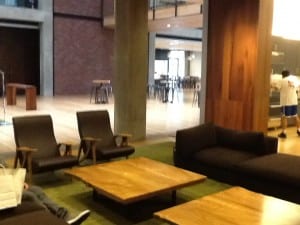 Situated among the sheds were regularly built offices that were no less decorated with themes and props. Victor told us he had worked in a shed once upon a time, but was booted out of his workspace for one of the more traditional offices. While he took us to his little corner of Pixar, he was unable to let us see his personal domain, hinting that he had confidential material relating to Inside Out stored inside. I could only imagine the concept art he was using for inspiration and wished there had been something on display for the new feature.
Situated among the sheds were regularly built offices that were no less decorated with themes and props. Victor told us he had worked in a shed once upon a time, but was booted out of his workspace for one of the more traditional offices. While he took us to his little corner of Pixar, he was unable to let us see his personal domain, hinting that he had confidential material relating to Inside Out stored inside. I could only imagine the concept art he was using for inspiration and wished there had been something on display for the new feature.
Most work places forbid their employees from partaking in alcohol while on the job, but Pixar takes the opposite approach by actually building bars within the studio. Victor’s office was actually next to one of the more easily accessible bars called Ye Olde Knife and Fiddle, which comes complete with bar stools, a booth, fake fireplace with a mounted gun over the mantle, and kitschy knick-knacks supplied by the animators. It reminded me of those family-friendly restaurant chains that decorate their walls with junk from thrift stores. Ye Olde Knife and Fiddle added attitude to the same theme with an aesthetic quality that bespoke of inside jokes and love for Pixar’s characters. There was a fist-sized hole in a wall that someone had framed. Victor told us that one of his co-workers had punched the wall when they had found out Disney bought Pixar. I guess not everyone was as pleased with the acquisition as I thought it made sense financially. There was also a portable tiki bar off to the side complete with a wooden tiki god that could have easily slipped into my backpack, but I am sure someone would have missed the little idol and I left him to stand guard over the bar. Someone suggested we pop open one of the bottles and share a drink, but sadly Victor pointed out that one of our group was not of legal drinking age. The kid flushed and looked sheepish, but we brightened the mood by heading off to see The Blue Umbrella.
It Has to be Copied from Photographs
We left the animation offices and Victor told us more about the Steve Jobs Building design. He motioned to the steel beams that were overhead and told us to look at the rivets. They were not real, but Jobs had them added because they were aesthetically pleasing. Victor also mentioned that the entire building was built on a spring foundation that would bounce when an earthquake struck, thus preventing it from damage. The idea of a building built on springs was a new thought and when we reached the ground floor I jumped on the wood flooring, hoping to bounce a few extra inches from the ground. There was no such luck and Victor laughed asking if I was trying to shake the entire building. It was a decent shot.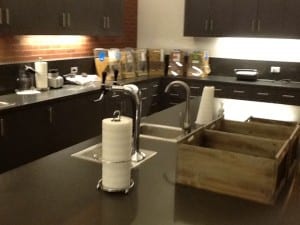
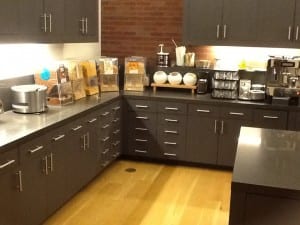
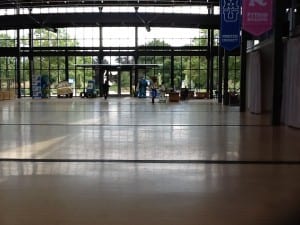
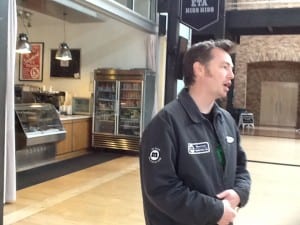
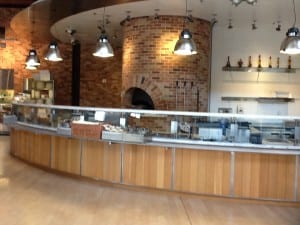

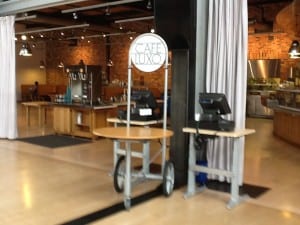
He led us past a kitchen with the fabled cereal bar and mailboxes nestled in the main atrium wall, to one of two viewing rooms the building used to show test footage. Another tour group consisting of children and their chaperones was using the theater for a Monsters University showing, that I wish we could have been on as well. My fangirl alarm went off again as we entered the viewing room and the upholstery jostled memories of interviews with Brad Bird, Andrew Stanton, and John Lasseter. This was one of the main areas where movies came to life beyond the animator’s computer. I bounced around in my seat imagining all the discussions that had taken place in that very room. As it was with the second floor, I was not allowed to take pictures of the viewing room itself and I cursed the copyright laws as the lights dimmed and the flutes and clarinets lowed from the speakers.
The viewing room totally blocked any outside light and the sound revolved around me in perfect clarity that fitted the mood of The Blue Umbrella, which takes place on a rainy day. All the inanimate objects in the city are personified, including gutters, mailboxes, and buildings. The city is delighted when the rain pours down, especially the umbrellas, who open up and play in the rain. One blue umbrella is enjoying the day more than usual when his human walks up beside another human with a red umbrella. The red and blue umbrellas have an instant attraction to each other, but are separated when their humans walk in different directions. The blue umbrella fights his way through the storm with the help of the city to get back to the red umbrella. Through a calamitous adventure the two umbrellas reunite and the short ends happily.
What astounded me the most about The Blue Umbrella was its realism. I do not mean the city coming to life, rather the animation quality. I was so sure it was photographs manipulated in a 3D environment. When the lights came on I asked Victor if that truly was a full-animated short and he said everything was rendered at Pixar. Part of me still did not believe him, until I was able to study the short in my own home with the pause button to find subtle giveaways (the humans’ gloves and boots and some textures on the buildings). The music was probably my favorite element, because it was light and airy and drove the story’s sweetness.
The animated short is highly underrated. The Blue Umbrella is a poignant piece that demonstrates within a few minutes and without voices, but full of human emotion, how far the medium can stretch to touch people.
Outside the Gate Again
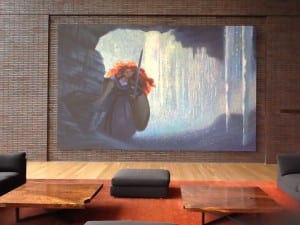 The short ended and Victor gathered us up again into the atrium and wondered what else he could show us. Several of us suggested the other buildings on campus, he pondered for a moment, then led us to the Brooklyn Building that had been built a few years ago. Unlike the Steve Jobs building, it was less open yet still had the organic flow quality. It reminded me of a ski lodge in the woods due to the wood paneling on the floor and walls as well as the fireplace in the center. There was another kitchen and restaurant, but we were not able to go upstairs. The Brooklyn Building was decorated with concept models and art from Ratatouille along with a giant bear statue and murals from Brave. It had a very calm and peaceful atmosphere, which made it hard to imagine it ever got rowdy.
The short ended and Victor gathered us up again into the atrium and wondered what else he could show us. Several of us suggested the other buildings on campus, he pondered for a moment, then led us to the Brooklyn Building that had been built a few years ago. Unlike the Steve Jobs building, it was less open yet still had the organic flow quality. It reminded me of a ski lodge in the woods due to the wood paneling on the floor and walls as well as the fireplace in the center. There was another kitchen and restaurant, but we were not able to go upstairs. The Brooklyn Building was decorated with concept models and art from Ratatouille along with a giant bear statue and murals from Brave. It had a very calm and peaceful atmosphere, which made it hard to imagine it ever got rowdy.
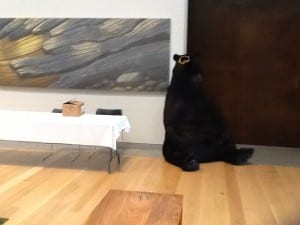 Studying his watch once more, Victor informed us that he had shown us everything he could and had to go home. It was 5:00 and I had spent a whole day at Pixar and it was still too short. Victor guided us out to the main gate, saying it was fun hanging out with all of us for the day. Out of a habit, I bent down and plucked a branch from the ground to play with as I walked. Victor saw me, smiled, and said “You have a souvenir.” He confused me for a moment, then I looked down at the stick. Yes, it was indeed a Pixar stick, but not quite what I had in mind as a souvenir. With great reluctance, I stepped through the security gate and faced the studio entrance. None of the grandeur had washed away and my expectations were beyond met. It was depressing having to step back into reality, when a creative place stood twenty feet away from me.
Studying his watch once more, Victor informed us that he had shown us everything he could and had to go home. It was 5:00 and I had spent a whole day at Pixar and it was still too short. Victor guided us out to the main gate, saying it was fun hanging out with all of us for the day. Out of a habit, I bent down and plucked a branch from the ground to play with as I walked. Victor saw me, smiled, and said “You have a souvenir.” He confused me for a moment, then I looked down at the stick. Yes, it was indeed a Pixar stick, but not quite what I had in mind as a souvenir. With great reluctance, I stepped through the security gate and faced the studio entrance. None of the grandeur had washed away and my expectations were beyond met. It was depressing having to step back into reality, when a creative place stood twenty feet away from me.
Creative End
I could finish this article off with a whimsy about how “dreams aren’t born they are made at Pixar,” or “it is a totally organic environment brought to life by its workers,” but how sappy would that sound? To keep my sadness company was a determination to get back to Pixar one day, but better and in a stronger capacity than I was during my tour. The next time I would come to Pixar would be the day I was there to create and if not that, I will take the next best thing.